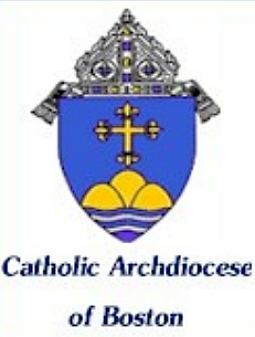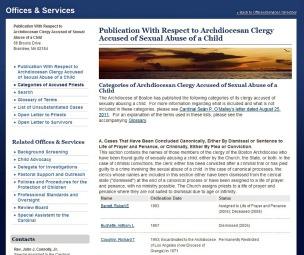By Joan Frawley Desmond
National Catholic Register
August 25, 2011
http://www.ncregister.com/daily-news/boston-archdiocese-posts-sex-abuse-database-online/
 |
 |
BOSTON — The Archdiocese of Boston today posted an online database of priests and deacons accused of the sexual abuse of minors, a landmark decision that signaled Cardinal Sean O'Malley's ongoing effort to break with the practices of episcopal negligence and secrecy that produced the 2002 scandal, forcing the resignation of Cardinal Bernard Law, his predecessor.
"In total, 159 names of accused clerics of the Boston Archdiocese are included on the lists being published today. Of these, 22 represent cases that are still in process canonically, with the priest on administrative leave and having no public ministry. It is my wish and goal that these remaining cases be processed as expeditiously as possible. At the conclusion of those cases, additional announcements and amendments to the list will be made accordingly," stated Cardinal O'Malley in his letter released Aug. 25.
The cardinal outlined the criteria used to include — or exclude — accused priests from the public listing, underscoring the complexity of establishing guilt in historical cases, which may date back decades, only to surface after the death of the accused.
The new website is likely to provoke controversy with some victim groups insisting that it does not go far enough, while advocates for due process for accused priests may challenge the decision to include deceased priests and those whose cases have not been fully adjudicated.
For several years, victim groups and plaintiff attorneys in Boston have called for such a list, and Cardinal O'Malley had signaled his desire to provide a centralized, accessible database of priests with credible accusation.
Father Richard Erikson, vicar general and moderator of the Curia for the Boston Archdiocese, said that the delay underscored the difficulty of compiling such a list with a high standard of accuracy and fairness.
Asked whether the list includes the names of priests who had not previously appeared in archdiocesan announcements, Terrence Donilon, a spokesman for the archdiocese, noted that the list incorporated public information from a variety of Church, media and clergy-abuse websites.
"It is possible that there are some names here that were not subject of a press release, probably not many," said Donilon.
In the wake of the 2002 Dallas Charter, the U.S. bishops have sought to facilitate public reporting of abuse allegations. Approximately 30 other dioceses have generated some kind of public list. Some lists are not routinely updated, and others have been dismantled; several independent national online websites also provide such information.
"The Dallas Charter is silent on whether or not those names should be posted. We go with the charter's standard of 'open and transparent.' To some that means posting a listing," said Mary Jane Doerr, associate director of the Secretariat for Child and Youth at the U.S. Conference of Catholic Bishops.
"The problem that others have with these listings is that if you are naming dead people who can't defend themselves it seems 'un-American,'" she added. "There is also concern about the range of behavior included, from criminal sexual conduct to someone consistently bending personal boundaries, leading to his removal."
In a five-page letter that addressed a range of complex issues — from grappling with the definition of "credibly accused" to posting the names of deceased priests who could not defend their reputations, the cardinal offered his personal deliberations and consultations with archdiocesan leaders, priests and victims as a humble work of penitence.
The cardinal acknowledged the debate regarding "the due-process concerns of those whose guilt has not been established. In the present environment, a priest who is accused of sexually abusing a minor may never be able to fully restore his reputation, even if cleared after civil or canonical proceedings. Reputational concerns also become acute in cases concerning deceased priests, who are often accused years after their death, with no opportunity to address the accusations against them."
The letter presented the policy of heightened transparency as a model for other dioceses and religious orders. The listing does not include accused priests who are not under the cardinal's authority. However, the cardinal's letter stated that the archdiocese reports accusations involving such priests to both the appropriate religious authority and local law enforcement and places the accused on administrative leave.
"To put this information in context, there have been to date a total of 250 clerics of the Boston Archdiocese accused of sexually abusing a minor," Cardinal O'Malley stated. "There are 91 names that are not being included on the lists published today, which can be summarized as follows: 62 names of deceased clergy as to whom canonical proceedings were never conducted or completed and who have not been publicly accused; 22 priests of the Boston Archdiocese as to whom the accusations of misconduct with a minor could not be substantiated; 4 priests or former priests of the archdiocese who are not in active ministry and are the subject of a preliminary investigation; and 3 priests who were already laicized or dismissed by the time they were accused and who have not been publicly accused."
The U.S. bishops' embrace of the Dallas Charter has provoked an ongoing and often contentious debate regarding the criteria used to trigger formal investigations of accused priests. Dioceses use the term "credible accusation" or "credibly accused" as a kind of shorthand for a range of allegations, from child rape to boundary violations that may involve non-sexual touching.
Philip Gray, an Ohio-based canon lawyer in private practice, expressed the concerns of many priests who fear that false accusations, virally spread across the Internet, could irreparably damage their good names and future ability to remain in ministry.
"Canon 1717, Paragraph 2 specifically states that in the preliminary investigation of a criminal case, 'care must be taken so that the good name of anyone is not endangered by the investigation,'" said Gray.
"Such listings substantially diminish the possibility of reintegration, if the priest is cleared. The court of public opinion is very strong in this country because of the abuses that have taken place," he added. "The reaction is strong against the bishops, but that reaction also negatively affects those wrongly accused. It renders it very difficult if such a priest is innocent."
The cardinal's letter noted that "the term 'credibility' can have a variety of meanings, and, in this context, can mean anything from 'plausible' but not proven, to 'more likely than not' (the standard used in civil cases), to the high standard used for convictions in criminal and canonical cases ('beyond a reasonable doubt'/subject to 'moral certitude'). I have decided instead to proceed by listing the names of clergy in the categories described above."
Asked to clarify the cardinal's approach, Father Erickson, the vicar general, explained that the trigger for including an individual priest was an accusation that "meets the low threshold — meaning it is not 'manifestly false.'"
Father Erickson described the online listing as a more accessible compilation of "information already in the public domain: previous statement made by the archdiocese or from other sources, such as media outlets, lawyers of victims and website registries such as BishopAccountability.org."
According to the cardinal's letter, the archdiocesan listing includes "the cleric's year of birth and year of ordination; whether the cleric is alive or deceased, and if deceased, the year of death; for members of the clergy who are alive, their status as well as the date of any laicization, dismissal or conviction of the accused cleric; and a link to the cleric's assignment history. This list, which is searchable, will be regularly updated as additional announcements are made in the future."
The names of priests publicly identified and subsequently cleared of such allegation, following a preliminary investigation or a canonical process, are included in a separate list on the website.
"In a number of cases, these priests have been returned to active ministry," said the cardinal. Exonerated priests who were not publicly accused have not been included in the public listings.
Father Erickson noted that a key benefit of this second list is that exonerated priests have "a clear record of their status. This gives priests a public document which they can point to and say the accusation has been unsubstantiated."
In his letter, the cardinal reported that "the vast majority of the complaints received by the archdiocese before 2004 involved incidents alleged to have occurred from 1965 to 1982, with a substantial decline in the number of incidents thereafter.
"Only 4% of the 198 allegations received by the archdiocese in the past six years involve child abuse alleged to have occurred more recently than 1990; over 90% of the incidents are alleged to have occurred before 1985," he stated.
But Cardinal O'Malley made it clear that these facts did not absolve the archdiocese of its responsibility to atone for past crimes, including negligence on the part of the bishops. He characterized the new initiative as "one more step forward in our efforts to assume responsibility for our past failures and reaffirm our commitment to assure that our present-day standards protect the children of our community."
He expressed his hope that the increased transparency would "provide some additional comfort and healing for those who have suffered from sexual abuse by clergy."
At the same time, the new website reflected the radically altered communications environment created by the Internet and the capacity of ordinary Catholics, victims and plaintiffs' attorneys to access once privileged information.
In 2002, the Boston Archdiocese was forced to open the contents of its once secret personnel files, revealing a pattern of gross episcopal negligence in the oversight of serial abusers and precipitating a scandal that forced the resignation of Cardinal Law.
Almost a decade later, the Boston Archdiocese signaled that it has embraced the modern practice of full disclosure as a tool of crisis management. The viral communication facilitated by the Internet is now impossible to ignore — even as the reality of human error and grave sin remain unchanged.
Any original material on these pages is copyright © BishopAccountability.org 2004. Reproduce freely with attribution.